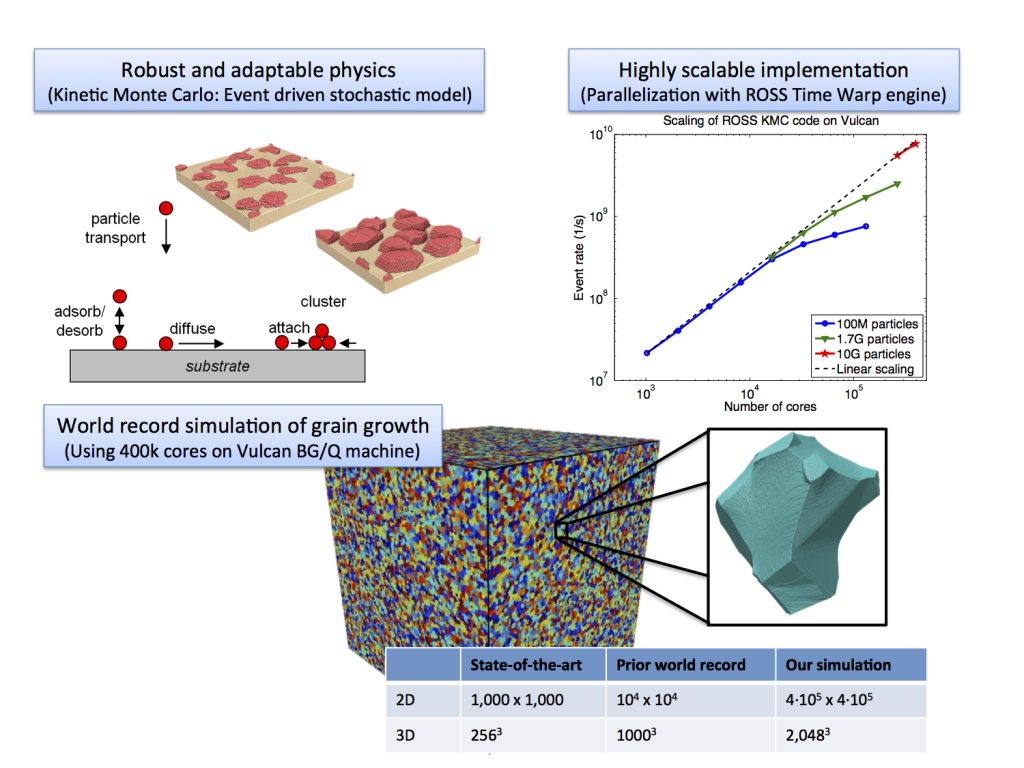Tomas Oppelstrup (14-ERD-094)
Abstract
Our goal is to develop algorithms for simulating materials on the mesoscale, using massively parallel kinetic Monte Carlo simulations in which results are calculated from random sampling. Current efforts in material engineering, device design, and manufacturing target length and growth time where multiple atomic mechanisms interact to define material structure, properties, and performance. Yet existing simulation methods fall far short of the relevant length and time scales. We plan to fill this capability gap by building a code based on the ROSS (Rensselaer's Optimistic Simulation System) discrete-event simulator, which has proven to be scalable to the full Sequoia supercomputer at Lawrence Livermore. Two selected test-bed applications are crystal film growth by deposition and grain boundary network dynamics. To enable fast development, the physical models will be imported into the ROSS simulator from existing Monte Carlo codes.
We will develop, benchmark, and optimize algorithms and software for parallel kinetic Monte Carlo simulations of materials at the mesoscale with atomistic resolution. We expect to be able to simulate 10 × 10 × 10 µm of material (~1013 atoms) grown at a rate of about 1 µm per minute at realistic physical deposition rates. This capability will enable simulation support for current efforts in additive manufacturing, rechargeable batteries, and high-powered magnets. We also expect to be able to simulate grain growth and coarsening kinetics in statistically representative (~103 grains), three-dimensional fragments of grain boundary networks over timescales identical to conditions used in laboratories to engineer novel high-performance materials resistant to thermal coarsening and irradiation. Successful completion of this project will aid in the development of several important mesoscale materials systems at the Laboratory across multiple programmatic areas.
Mission Relevance
Development of mesoscale atomistic simulation will enable LLNL to meet important mission needs for stockpile stewardship and energy security with growth of thick beryllium films for fusion ignition capsules, grain boundary engineering for enhanced radiation tolerance, fabrication of unconventional material architectures by additive manufacturing, and highly ramified (branch-like) material interfaces for energy storage. In addition, understanding material behavior at the mesoscale through advanced simulations on high-performance supercomputers supports the Laboratory's core competencies in advanced materials and manufacturing and high-performance computing, simulation, and data science, and was identified as a national priority in a recent DOE Basic Energy Sciences advisory committee report, From Quanta to the Continuum: Opportunities for Mesoscale Science.
FY15 Accomplishments and Results
In FY15 we (1) implemented support for general potentials, such as the embedded atom model (a model of the energy between atoms), into our kinetic Monte Carlo framework and incorporated support for several different lattice types; (2) added features to the ROSS simulator to better support kinetic Monte Carlo applications; and (3) demonstrated the scalability of our code to over 250,000 tasks.






